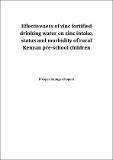| dc.contributor.author | Prosper Kujinga, Valeria Galetti, Elizabeth Opiyo Anyango, Viktor Jakab, Simone Heeb, Pauline Andang’o, Inge D. Brouwer, Michael B. Zimmerman, Diego Morett | |
| dc.description.abstract | Background: Zinc deficiency is considered a significant public health problem in preschool
children in Africa together with infections such as diarrhea, which further deplete the body of
zinc. Young children are more vulnerable to zinc deficiency due to increased requirements and
frequent infections. Zinc fortified water is one way of improving zinc intake and reducing
diarrheal infections in such vulnerable groups. Vestergaard Frandsen has developed a point-ofuse device capable of purifying and concomitantly fortifying water with zinc at concentration
ranges of ≈ 1-4mg/L. This filter is meant for households in areas of poor socioeconomic status
with limited access to improved water sources. The overall aim of this thesis is to assess the
contribution that zinc fortified water can make to zinc intake and bioavailability in children
aged 2-6 years old from rural Western Kenya.
Methods: The investigations in this thesis comprise a cross sectional and effectiveness study
conducted in rural Western Kenya and a stable isotope study conducted in Switzerland. Firstly
we assessed the baseline prevalence of zinc, iron and vitamin A deficiency in 461 children aged
between 2-6 years in rural Western Kenya in a cross sectional study. We conducted a stable
isotope study in Swiss adults to determine bioavailability of zinc from zinc fortified water
produced by a household water purification and fortification device – the Lifestraw Family filter
(LSF filter). Furthermore we conducted laboratory trials to investigate effect of usage pattern
and idle time on zinc elution levels. Next we investigated the effectiveness of daily consumption
of zinc fortified water on zinc intake, zinc status and morbidity in rural Kenyan children 2-6
years old (n=184). Lastly we used dietary intake data of the children involved in the
effectiveness trial to develop food based recommendations that should accompany the
introduction of zinc fortified water to ensure overall nutrient adequacy.
Results: The results indicated that zinc and iron deficiency were highly prevalent and affected
74% and 61% respectively of the children. Vitamin A deficiency affected 34% of the children.
Inflammation was high in this population and applying published approaches to correct
nutrient biomarker for inflammation led to varying estimates of deficiency. Percent decrease in
zinc and vitamin A deficiency ranged from 2-19%, and 43-78% respectively, with iron
deficiency (definition inclusive of soluble transferrin receptor) decreasing by 10% using
exclusion method and increasing by range 0.6-3.6% by all other approaches. The stable isotope
study showed that geometric mean (-SD, +SD) fractional absorption was 65.9% (42.2, 102.4)
from fortified water, higher (p<0.01) than 9.8% (5.7, 16.7) and 9.1% (6.0, 13.7) when either
water was fortified and consumed with maize or when maize was fortified and consumed with
water, respectively (p<0.01). Zinc elution was higher in filters used to treat 2L/day
(4.7±1.6mg/L) than 10L/d (1.7±0.9) and 20L/d (1.3±0.7mg/L) (p<0.05). Percent increase in
zinc eluted after 1 week storage was 23.4% (2L/d), 82.4% (10L/d) and 43.1% (20L/d). After
the second week of storage, zinc elution further increased by 56.9% (2L/d), 12.9% (10L/d) and
7.5% (20L/d), compared to previous week of continuous usage. Daily consumption of zinc
fortified water at the rate ≈461ml/d per child, contributed 42% and 36% of daily requirements
for absorbable zinc in children 2-3 and 4-6 years respectively. Zinc fortified water decreased
overall morbidity (RR=0.91; 95%CI: 0.87, 0.96), morbidity due to colds (RR=0.91; 95%CI: 0.83,
0.99) and stomach pain (RR =0.70; 95%CI: =0.56, 0.89) and a significant reduction for diarrhea
in the per protocol analysis, (RR=0.72; 95%CI: =0.53, 0.96). There was no treatment effect on
plasma zinc concentration and stunting. The final set of FBRs developed comprised unfortified
viii
whole grain products (14 serves per week), unfortified fluid or powdered milk (7 serves per
week), nuts and seeds (4 serves per week), vitamin A rich vegetables (7 serves per week), other
starchy plants (7 serves per week), vitamin C rich vegetables (7 serves per week) and small
whole fish with bones (7 serves per week). These FBRs achieved nutrient adequacy for all
nutrients except for vitamin A (25%RNI) and folate (68%RNI).
Conclusion: We have shown that in areas at elevated risk of zinc deficiency and with limited
access to improved water sources, daily consumption of zinc fortified water contributes
substantially to daily zinc intake and is effective in reducing prevalence of common infectious
morbidity in children. A single nutrient intervention such as zinc fortified water must be
accompanied by food based recommendations in order to fulfill nutrient gaps as these
communities often suffer from multi micronutrient deficiencies. In areas with high prevalence
of deficiencies, correcting nutritional biomarker for inflammation does not change the
conclusion that deficiency levels are of public health relevance. | en_US |

